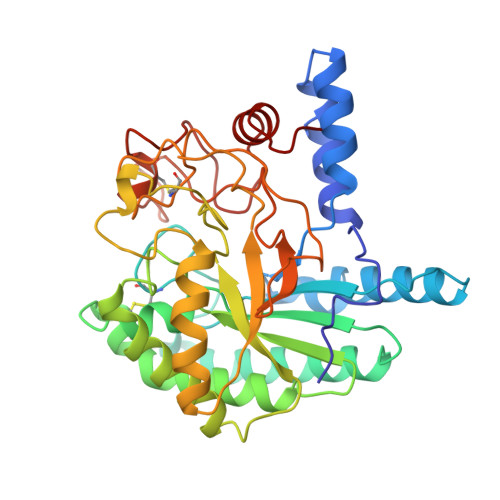Structural changes of the active site tunnel of Humicola insolens cellobiohydrolase, Cel6A, upon oligosaccharide binding.
Varrot, A., Schulein, M., Davies, G.J.(1999) Biochemistry 38: 8884-8891
- PubMed: 10413461
- DOI: https://doi.org/10.1021/bi9903998
- Primary Citation of Related Structures:
2BVW - PubMed Abstract:
The mechanisms of crystalline cellulose degradation by cellulases are of paramount importance for the exploitation of these enzymes in applied processes, such as biomass conversion. Cellulases have traditionally been classified into cellobiohydrolases, which are effective in the degradation of crystalline materials, and endoglucanases, which appear to act on "soluble" regions of the substrate. Humicola insolensCel6A (CBH II) is a cellobiohydrolase from glycoside hydrolase family 6 whose native structure has been determined at 1.9 A resolution [Varrot, A., Hastrup, S., Sch¨¹lein, M., and Davies, G. J. (1999) Biochem. J. 337, 297-304]. Here we present the structure of the catalytic core domain of Humicola insolens cellobiohydrolase II Cel6A in complex with glucose/cellotetraose at 1.7 A resolution. Crystals of Cel6A, grown in the presence of cellobiose, reveal six binding subsites, with a single glucose moiety bound in the -2 subsite and cellotetraose in the +1 to +4 subsites. The complex structure is strongly supportive of the assignment of Asp 226 as the catalytic acid and consistent with proposals that Asp 405 acts as the catalytic base. The structure undergoes several conformational changes upon substrate binding, the most significant of which is a closing of the two active site loops (residues 174-196 and 397-435) with main-chain movements of up to 4.5 A observed. This complex not only defines the polysaccharide-enzyme interactions but also provides the first three-dimensional demonstration of conformational change in this class of enzymes.
Organizational Affiliation:
Structural Biology Laboratory, Department of Chemistry, University of York, U.K.























